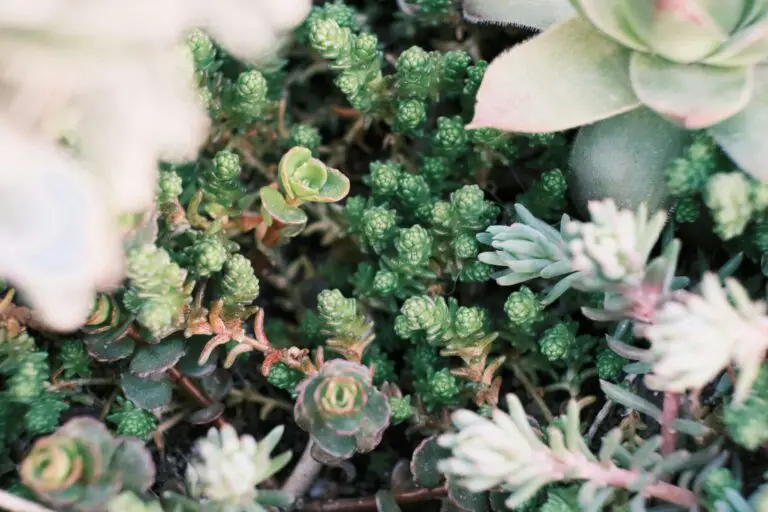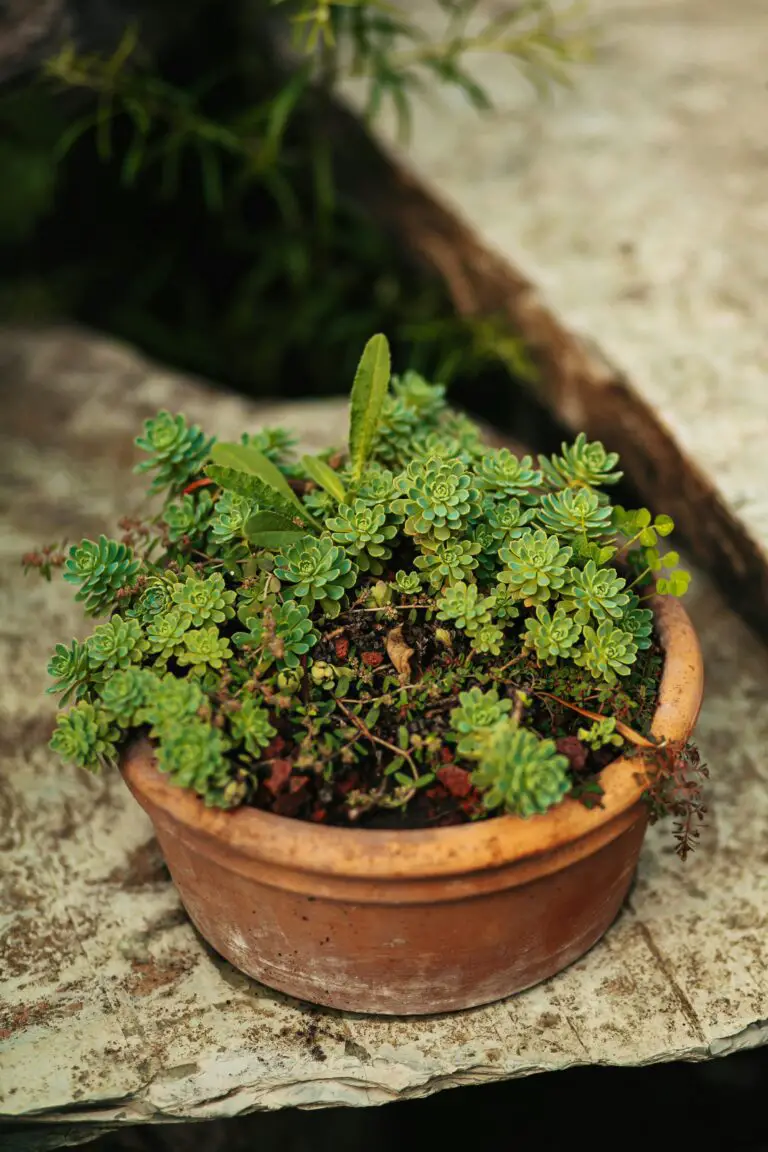Introduction to Sedum and Weed Management
Imagine a vibrant carpet of sedum plants cascading over your garden bed, a living tapestry that not only delights the eye but also promises a fierce battle against unwanted weeds. Sedum, a striking garden plant known for its hardiness and drought tolerance, steps into the ring with unassuming confidence. But can it really hold its own against pesky invaders?
Ground cover plants like sedum are the unsung heroes of weed management. They spread quickly, creating a dense mat that leaves little room for weeds to take root. Picture a game of musical chairs where sedum has claimed nearly every seat, and weeds are left awkwardly standing, waiting for an opportunity that never comes.
Competition for resources is an intense rivalry in the plant world. As sedum blankets an area, it monopolizes the crucial supplies of sunlight, water, and nutrients, effectively starving any unwelcome plants trying to grow. In a way, sedum isn’t just growing in your garden; it’s patrolling it, casting a watchful eye over its leafy domain.
For those seeking insights into the nuances of sedum and its growth habits, Creeping Thyme offers an interesting comparison. As a fellow ground cover, it poses the same question: how do these plants interact with their environment to become such effective weed suppressors?
Intrigued by the tenacity of sedum and its ability to flourish under various conditions? Take a stroll through our guide on cultivating your own sedum sanctuary, and discover the optimal care practices to maximize your garden’s potential. Whether amidst stones or in the delicate shade, learn how sedum’s adaptability makes it a valuable ally in the quest for a weed-free oasis.
Understanding How Sedum Grows
Imagine a plant so tenacious and robust that it not only beautifies your garden but also wages war against those pesky weeds. Welcome to the world of Sedum, a hardy succulent that’s not just a feast for the eyes but also a possible bane for weeds. Let’s dive into the secrets behind Sedum’s growing prowess and its fight club tactics against unwelcome green intruders.
Sedum is a marvel of nature, spreading its influence across your garden through its strong, sturdy roots and dense foliage. With a spreading nature akin to a gentle wave covering the shoreline, Sedum establishes its presence without much ado. The roots tether themselves to the soil with determination, silencing the crowd of weeds that dare to compete for nutrients and water. But it doesn’t end there: the foliage, a lush tapestry of leaves, creates a canopy so compact that even sunlight struggles to sneak through to the soil below.

Consider this real-life example: A gardening enthusiast plants Sedum ‘Autumn Joy’ along her walkway. Soon, she observes fewer dandelions and crabgrass popping up. It is as if the Sedum is a silent sentinel, warding off the advances of the unwanted weeds. This isn’t a mere coincidence; it’s the Sedum’s dense growth habit in action, proving its worth as a ground cover that not only pleases the eye but also serves a practical purpose.
Is this growth habit universal across all Sedum varieties? Most definitely! Whether it’s the vibrant Sedum spurium ‘Dragon’s Blood’ or the stoic Sedum reflexum ‘Blue Spruce’, their foliage forms a dense mat that is unyielding in its quest to dominate the space it occupies. Each leaf unfolds, creating a stagnating environment for weeds below, depriving them of life-sustaining sunlight and space to grow.
If you’re curious about how to make the most of Sedum’s weed-smothering abilities or require some helpful gardening tips, it’s worth exploring further. Sedum doesn’t just grow; it thrives with a bit of the right guidance, creating vibrant, virtually weed-free landscapes.
So, does Sedum choke out weeds? The answer is in the very nature of its growth. When positioned as a living, breathing weed barrier, Sedum does seem to have the upper hand. It occupies the soil kingdom with its dense, impermeable cloak of greenery, making it challenging for any weed to declare its territory. It’s not a garden myth; it’s Sedum’s very own game of thrones!
Comparing Sedum to Traditional Weed Barriers
Imagine for a moment: a garden where the vibrant cascades of succulent sedum leaves weave a carpet so dense that even the most tenacious of weeds concede defeat. Does this sound too good to be true? Let’s discover the reality as we compare sedum, a popular ground cover, with tried-and-true methods like mulching, landscape fabric, and chemical herbicides.
Sedums, with their alluring foliage and tough-as-nails attitude, quietly stake their claim in the ground cover arena. But are they the unsung heroes in the battle against weeds? Mulching, the gardener’s go-to for suppressing unwanted green invaders, works by smothering weeds and blocking sunlight. However, sedum takes a different approach. This living mulch blankets the earth, presenting an unyielding front to any would-be squatters.

Landscape fabric, a perennial favorite for its supposed weed-blocking prowess, can be fouled by tears and deterioration over time. Sedum, on the other hand, remains steadfast and self-healing. Physical damage is quickly concealed by new growth, ensuring a seamless guard against weeds. But before we crown sedum as the garden guardian, let’s factor in chemical herbicides. While these may offer a quick fix, they come with a cascade of ecological concerns and potential health risks – a price the eco-conscious gardener is unwilling to pay.
Real-life gardeners often share anecdotal evidence about sedum’s weed-suppressing abilities. Picture the once weed-ridden nook of a backyard now thriving with ‘Dragon’s Blood’ sedum, a patch once prickly with thistles now a serene sea of green. However, is anecdotal evidence enough to trust sedum as a reliable weed barrier? Research and garden trials continue to explore the true extent of sedum’s abilities in this regard.
Let’s not forget that sedum also brings a host of other benefits for gardeners seeking effective garden practices. Its drought tolerance makes it a low-maintenance ally for those in arid climates, while its ability to attract pollinators enhances the biodiversity of the garden ecosystem.
Whether sedum can truly outshine the efficacy of mulch, landscape fabric, and herbicides is still a subject of debate. Yet, its virtues are hard to ignore. It’s a lush, living barrier that could just be the weed suppressing solution gardeners have been seeking. So why not give sedum a chance to prove its mettle in your garden conquests?
The Benefits of Choosing Sedum for Landscaping
Envision a carpet of vibrant greens and rich purples spreading across your garden, a living kaleidoscope that ebbs and flows with the seasons. This isn’t just a flight of fancy; it’s the reality when you introduce sedum, a hardy succulent, into your landscaping. Known for its dense growth and ability to thrive in challenging conditions, sedum is often hailed as a stalwart guardian against the onslaught of weeds.
But what truly sets sedum apart in the botanical lineup? Well, let’s take a dive into the realm of this resilient plant. Sedum’s secret weapon in the green battleground comes from its mat-forming habit. As it grows, it forms a thick, impenetrable layer that blankets the soil, making it tough for unwelcome plant invaders to gain a foothold. Picture last summer: the unrelenting battle against weeds that seemed to spring up overnight. Now imagine replacing that with sedum; its very presence acts like a green shield, safeguarding your garden from these pesky invaders.

Sedum isn’t just a defensive player; it’s an aesthetic powerhouse too. With a variety of species and hybrids, ranging from the stonecrop’s petite rosettes to the taller, statuesque spectabile, sedum brings a diverse palette to your garden’s canvas. Each variety blooms with star-shaped flowers that become a beacon for pollinators. By choosing sedum, you’re not only enhancing your garden’s look but also fostering a haven for biodiversity, supporting bees, butterflies, and other beneficial insects.
If you find yourself sighing over the hours spent on garden upkeep, sedum might just be your new best friend. Once established, these plants are virtually maintenance-free. They shrug off drought, laugh in the face of frost, and demand little more than a sunny spot to thrive. By integrating sedum into your garden, you can reclaim your weekends, trading in the tedium of weeding for the tranquility of enjoying your outdoor sanctuary.
From first-time gardeners to seasoned green thumbs, sedum presents a compelling case for those seeking beauty without the bother. Its low-maintenance personality, combined with its toughness and versatility, makes it an exemplary choice for a fuss-free landscape that stays lush with minimal effort. So go ahead, plant that sedum and watch as your garden transforms into a fortress against weeds and a bastion of beauty.
Potential Challenges and Considerations
Imagine you’ve got a vibrant swathe of sedum in your garden, looking so lush that it’s the envy of every green thumb in the neighborhood. But, hold on! Is this robust ground cover the silver bullet to banish those pesky weeds for good? Well, things aren’t always as straightforward as they seem in the tangle of garden warfare. Let’s dig into the dirt and uncover some truths about using sedum as a weed suppressant.
When you plant sedum, you might expect a plant cavalry charging in to choke out the weeds. Unfortunately, nature doesn’t always comply with our battle strategies. Selecting the appropriate sedum species is more crucial than you could realize. Not all sedum varieties have the same weed-fighting gusto. Some are like tenacious soldiers, spreading fast and thick to shield the soil from the weed invaders. Others are more like gentle peacekeepers – nice to look at, but not so effective on the front lines against weeds.
Take, for example, the tale of two gardens. In one, ‘Dragon’s Blood’ sedum was chosen, and it formed such a dense carpet that even the most ambitious weed seeds couldn’t muscle their way through. But in the adjacent plot, a more polite variety of sedum was planted, and the gardener soon found they had to join the fray with a trowel in hand, doing battle with weeds that poked through like uninvited guests.
And that brings us to another key point—the potential need for occasional weeding. It’s a dream to think that any ground cover, even the formidable sedum, could create an impenetrable barrier to weeds. Nature is persistent, and some weeds are nothing if not opportunistic. They’ll find those little nooks and crannies in your sedum shield, and before you know it, you’re pulling up dandelions and crabgrass. So, brace yourself for the possibility that you might have to do some weeding from time to time.
If you’re drawn to the allure of sedum’s low-maintenance charm, don’t let these potential challenges deter you. With some savvy planning and species selection, your garden can be both a feast for the eyes and a fortress against weeds. After all, isn’t the joy of gardening found in these very battles and triumphs?
For more insights, take a peek at this video that discusses some excellent ground cover choices and their effectiveness in keeping those unrelenting weeds at bay:
Expert Tips for Planting and Caring for Sedum
Whether you’re a seasoned gardener or a green-thumbed newbie, the question of “will sedum choke out weeds” can spark a flurry of curiosity. But before we dig into the nitty-gritty of weed suppression, let’s talk about planting and caring for these resilient succulents. After all, a sedum that’s well planted and cared for is your first line of defense against those pesky invaders.
Imagine a lush carpet of sedum in your garden—their plump, vibrant leaves interweaving to form a living tapestry that’s not only eye-catching but a formidable foe for weeds. To create this green haven, it’s vital to start with the right planting techniques. Unlike more finicky plants, sedum thrives even in the rockiest and most challenging soils, clamoring for sunlight like sunbathers on a beach. However, to truly give weeds the boot, plant your sedum in well-draining soil, and give it plenty of room to spread its wings—or in this case, its roots and stems.

Propagation isn’t just a fancy term for gardeners; it’s a sedum superpower. With a few simple steps, you can multiply your sedum stock and create that dense coverage that will make weeds think twice about settling in. Take a leaf or a stem cutting, let it callous over for a day or two, and then gently tuck it into the soil. With the magic touch of water and sunshine, you’ll have baby sedums sprouting faster than you can say “weed invasion.”
Maintenance is the final chapter in our sedum story. These hardy perennials are like the self-sufficient teens of the plant world, needing little pampering to thrive. But to keep your sedum at peak performance in the fight against weeds, ensure they get enough water during dry spells and trim back any overzealous growers to maintain that impenetrable ground cover. Remember, while sedum is tough, it’s not invincible; a little TLC goes a long way in keeping your sedum garden healthy and weed-free.
Maintaining an Unyielding Defense Against Weeds
Think of maintaining your sedum as preparing an army for battle. Every bit of care you provide equips these succulent soldiers to stand guard against the onslaught of weeds. With good planting practices, effective propagation, and diligent maintenance, your sedum won’t just choke out weeds; it’ll reign supreme in the plant kingdom, with no unwelcome green invader daring to cross its path. Get your gloves on, grab your gardening tools, and prepare to plant, propagate, and protect your way to a sedum sanctuary.
Case Studies: Real-life Examples of Sedum in Action
The perennial powerhouse known as sedum has an impressive resume when it comes to landscape management. Let’s dive into some real-world scenarios where this succulent hero has made its mark—or struggled to do so—against nature’s green invaders.
Garden Guardians: Sedum’s Battle in Backyard Biomes
In the domestic sphere, homeowners have reported a sea of change when introducing sedum to their gardens. Specifically, those who planted ‘Dragon’s Blood’ sedum witnessed a dramatic turn. Its quick growth and dense mat-forming habit provided a natural mulch over the soil, effectively suppressing a variety of weeds. It seemed as though the weeds had finally met their match, relinquishing their grasp as sedum covered the soil like a verdant shield.

The Rooftop Rebellion: How Sedum Stood Its Ground
Let’s elevate the conversation—literally. Green roofs across urban landscapes have adopted sedum as the flora of choice to combat unwanted plants. Why? Its shallow root system and drought tolerance make it an ideal candidate for such heights. In a case study from a metropolitan area, sedum installations contributed to a notable reduction in maintenance. Previously persistent weeds now faced a rooftop rival that absorbed resources, leaving less for the weeds to thrive.
When Sedum Succumbs: A Tale of Persistence Over Perfection
However, it’s not always a success story. In certain cases, sedum has met its match. One study conducted on highly invasive species like bindweed found that while sedum can suffocate some competitors, those with deeper roots or aggressive growth patterns can break through the sedum shield. This serves as a reminder that there’s no one-size-fits-all when it comes to weed management, and even sedum may require reinforcements in such resilient circumstances.
So, does sedum choke out weeds? The narratives above illustrate a winning streak with caveats. Admittedly, like any garden variety vigilante, sedum has its kryptonite. Yet, its resume boasts enough successful testimonials to merit a nod of approval for weed suppression—for the most part.
It appears there was a misunderstanding in the previous response. Let’s correct that:
Case Studies: Real-life Examples of Sedum in Action
When it comes to garden warfare, sedum can be a real heavyweight contender. Gardeners from all walks of life have pitted this plucky plant against intrusive weeds, often with great success. Picture this: a verdant sprawl of sedum ‘Dragon’s Blood’, with its star-shaped flowers, throttling the life out of pesky weeds beneath. Not only does it pack a visual punch, but this sedum variety forms a dense carpet that’s tough for weeds to penetrate.

Let’s step into the world of a suburban homeowner—John, let’s call him—who was battling a relentless wave of bindweed. After introducing sedum ‘Autumn Joy’ to his garden borders, John found his summers less consumed by weeding. The sedum spread quickly, crowding out the unwelcome visitors without a single drop of herbicide. Score one for John, and for sedum’s natural weed-suppressing abilities!
But it’s not just small-scale victories that have been won. Consider the case of a city park, once a hotspot for weed growth, transformed by a sea of sedum. The park’s groundskeeper, Emma, integrated various sedum species throughout the landscape. She observed a marked reduction in weed presence, attributing it to the sedum’s ability to thrive in arid conditions where most weeds simply could not compete. It was a low-maintenance, sustainable win for the city’s green space.
Admittedly, sedum isn’t invincible. There are reports of the plant meeting its match against certain tenacious weeds or in environments not suited to its growth. One case study reveals that in particularly shady and moist areas, sedum’s weed-fighting prowess diminished, giving ground to more adaptable weed species. This just goes to show, while sedum can be a formidable foe against weeds, it’s not a silver bullet. Situational awareness is crucial in any botanical battle.
In conclusion, while we haven’t quite unearthed a horticultural panacea, sedum’s track record in real-life scenarios suggests it’s a robust ally in the ongoing skirmish with weeds. The examples above shed light on this succulent’s impressive capabilities—and its limitations—providing invaluable insights for anyone considering sedum as a natural weed suppressant.
Further Ways to Enhance Weed Suppression Through Gardening Practices
While sedum plants are a formidable first line of defense in the battle against weeds, we can’t rely solely on their attractive, dense foliage to vanquish every unwanted invader. To craft a garden that’s virtually impenetrable to pesky weeds, we need to dive deeper into the soil of knowledge and unearth additional strategies that complement sedum’s natural prowess. Think of it as assembling a superhero team for your garden – each member brings their own unique strengths to create an unstoppable force.

First and foremost, the health of the soil is paramount. Just as a robust immune system in humans can fend off disease, healthy soil is the key to growing strong plants that can outcompete weeds. One real-life hero in this tale is compost – a treasure trove of organic matter that not only feeds your sedum but also improves drainage and aeration. A soil rich in compost is like serving up a gourmet meal to your plants while leaving weeds with meager scraps.
Space It Out: The Art of Adequate Plant Spacing
Moving on, we come across the art of spacing – it’s like social distancing for plants. Too close a congregation can stifle growth and invite disease, but just the right amount of space can enhance air circulation and light penetration, enabling your sedum to thrive. Picture each plant as an individual, flourishing unencumbered, and you’ll soon have a tapestry of foliage so dense that weeds dare not tread.
Companion Planting: Allies in the Garden
Lastly, let’s not overlook the power of friends – or in the gardening world, companion plants. Positioning friendly flora alongside your sedum is akin to building an alliance against common foes. Take, for example, marigolds, which unleash a secret weapon into the soil to deter nematodes, or garlic, which releases deterrent chemicals to repel aphids. By introducing such companions, you not only boost your garden’s defense system but also create a symphony of color and fragrance to delight the senses.
All these tactics, when aligned with the natural armor of sedum, forge a garden that’s not merely a visual splendor but also a fortress against the tireless advance of weeds. It’s a holistic approach to garden supremacy – one that requires patience, care, and a touch of ingenuity.
Frequently Asked Questions
When it comes to beating the battle against weeds, many gardeners turn to nature’s own arsenal, and among the green knights of the garden turf, sedum plants often come to the fore. Commonly known as stonecrop, sedum is hailed for its thick, succulent leaves that form dense mats upon the ground. But does this hardy hero actually have the power to vanquish those persistent invaders—the weeds?

Can Sedum Really Keep Weeds at Bay?
The truth is, sedum plants can indeed make life tough for weed species. Their lush foliage forms a living mulch, shielding the soil from the sunlight that weeds crave. Furthermore, by covering the ground so comprehensively, they limit the real estate available for weeds to establish. This is not just a theory; it’s a practice adopted by many a seasoned gardener who looks to sedum to maintain a low-maintenance and aesthetically pleasing ground cover.
Does the Type of Sedum Make a Difference in Weed Control?
Indeed, not all sedums are created equal. Some, like the ever-popular ‘Dragon’s Blood’ sedum, create such a tight blanket of leaves that they leave no room at the inn for unwanted plant squatters. Others may offer less coverage, providing occasional nooks and crannies where a particularly tenacious weed might sprout. The key is to choose varieties known for their dense growth habit if you’re arming your garden against weeds.
Are There Real-Life Examples Demonstrating Sedum’s Effectiveness?
Picture a sunny rock garden where sedum varietals bask alongside boulders, their fleshy mats interwoven so tightly that not a single dandelion dares to pop its head. Or consider a green roof project, where sedum species are selected specifically for their ability to outcompete weeds while bolstering the roof’s integrity with minimal upkeep. These are not just picturesque scenarios; they are real-life testimonies to sedum’s prowess in the fight against weeds.
What About Maintaining Sedum to Ensure Optimal Weed Suppression?
Maintenance is fairly straightforward—sedum is a set-and-forget kind of plant. However, even the most stalwart weed warriors need a little TLC. Ensuring your sedums are healthy involves minimal watering, occasional weeding, and perhaps an annual trim to keep them thick and robust. A flourishing sedum is a formidable foe to weeds, so a bit of care goes a long way.
Conclusion
In conclusion, while sedum plants offer a natural and attractive solution to suppress weeds, they are not a silver bullet. Choosing the right variety and providing basic care will enhance their effectiveness. By integrating sedum into your garden strategy, you’re not just choosing a plant; you’re enlisting a garden ally in the perpetual skirmish against those unwelcome weeds.



